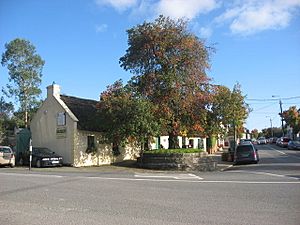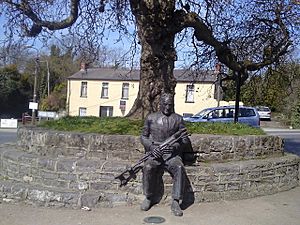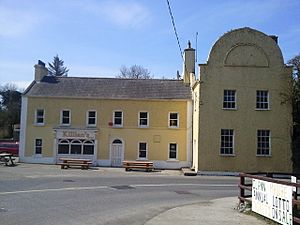Naul, Dublin facts for kids
Quick facts for kids
Naul
Irish: An Aill
|
|
|---|---|
|
Village and district
|
|

Séamus Ennis Arts Centre, Naul
|
|
| Country | Ireland |
| Province | Leinster |
| County | County Dublin |
| Local government area | Fingal |
| Elevation | 75 m (246 ft) |
| Population
(2016)
|
|
| • Urban | 568 |
| Irish Grid Reference | O130609 |
Naul (pronounced "Nawl"), also known as "The Naul," is a small village in Fingal, which is part of County Dublin in Ireland. Its Irish name is An Aill, meaning "The Cliff."
The village is located at the northern edge of County Dublin. The Delvin River flows north of the village. This river also marks the border between County Dublin and County Meath. Naul is part of the historic area called Balrothery West.
Contents
Location and Geography
Naul village is found where two main roads meet: the R122 and the R108. The R108 is an old route that connects Dublin to the port town of Drogheda. The R122 travels from Finglas in the south to Balbriggan.
The River Delvin flows through Naul in the north. It runs through a deep valley called 'The Roche'. This valley has steep banks and rocky cliffs that can be up to 20 metres high. You can find a natural waterfall here, known as 'Waterfall of The Roches'. Further down the river, a dam has created an artificial pond and a small waterfall. There is also a small private power plant that uses the river's water to make electricity.
Naul village and the areas around it are on the northern border of County Dublin and Fingal. However, the area known as Naul also stretches north into County Meath. The part of Naul in north County Dublin covers about 2,627 acres. It includes 15 smaller areas called townlands.
What's in a Name?
The name "Naul" comes from the Irish words An Aill. This means "The Cliff". There are large cliffs on both sides of the River Delvin just outside the village.
Even though it's not official, many people still call the village "The Naul". This is a reminder of its original Irish name.
A Look at History
People have lived in the Naul area since the Stone Age. This is known because many old earthworks (structures made of earth) have been found here. Also, the Fourknocks passage tomb is nearby. This ancient burial site is about 2.5 kilometres north of the village in County Meath.
The Fourknocks tomb was found in 1949. Four ancient mounds were discovered. They contain a chamber that is even wider than the one at Newgrange. Inside the passage, there are strange stone carvings. These carvings show that the chambers were built about 4,000 years ago.
The Black Castle
Just a short distance north of the graveyard, you can find the ruins of the Black Castle. It is now covered in old ivy. This castle was once called "one of the most beautiful ruins of its kind in Ireland."
The Black Castle is also known as Castle of the Roches, Cruise's Castle, or Naul Castle. It stands proudly on a rocky cliff, looking over the valley of Roches. It rises more than 45 metres high. The Black Castle guarded the Dublin side of the valley. On the other side of the Delvin River, in County Meath, stood the White Castle. Both castles were named after the colour of the stone they were built from.
This strong castle was likely built by the Norman De Geneville family around the end of the 12th century. It was protected by a steep cliff on its north and east sides. On the west, it had strong walls and a large open area to keep cattle safe. Around the year 1200, the castle became part of the Cruise family through marriage. Stephen De Crues was one of the first Norman settlers in Ireland. His descendant, Sir John Cruys (who died in 1407), was a famous soldier and diplomat. Naul was one of his many properties.
Around 1200, a church belonging to Stephen de Crues was mentioned. It is thought to have replaced an older Celtic holy place where the current graveyard is. This Catholic church had priests for 300 years. It became a Protestant church during the time of Elizabeth I. By 1630, it was in ruins. A new Protestant church was built in 1818 in the graveyard. It was later taken down in 1949 because it was no longer used.
In 1641, Christopher Cruise owned "one old castle with an old hall covered in straw, one orchard, one garden plot, ten houses and the walls of the parish church." However, the Cruise family's time in Naul was ending. They lost their castle and lands when they took part in the rebellion of 1641. Oliver Cromwell attacked and destroyed the castle in 1649. It is said that 40 defenders were killed, and only one woman escaped. This marked the end of the Cruise family's rule in Naul.
It is believed that Oliver Plunkett often visited the Black Castle. Legend says he was captured here for preaching during a time when it was against the law. Plunkett was the last religious person to be executed in England in a very harsh way. His head is now on display in St. Peter's Church in Drogheda.
In 2013, American actor Tom Cruise visited Ireland. He was told that his ancestors were the Cruises of Naul. This was discovered through a family history project for The Gathering Ireland 2013.
In 1966, a large part of the castle, including a spiral staircase, fell down. It is now half the size it used to be. Large parts of the north and east walls still stand, but ivy is slowly damaging the 800-year-old ruins.
The White Castle
North-west of the Black Castle, across the Delvin River in County Meath, the White Castle once stood. This castle, also known as Snowtown Castle, was likely built in the 13th century. It was built by the Caddell Family, who were given land along the Meath border of Naul. 'Snowtown Castle' is shown on an old map from 1760.
When Austin Cooper visited Naul in 1781, he wrote about the White Castle. He described it as a "large square castle, with towers at each corner." He also noted that it was very ruined, but still showed signs of once being a beautiful and important place with gardens and terraces.
The Caddells were forced out by Oliver Cromwell's general in 1649. The lands were later given to Arthur Mervyn, who built three mills in Naul. The Pollard family later owned the White Castle and the land around it. In 1787, the castle was torn down. A part of the castle's east wall was later used in Naul Park House, built around 1800. The Ennis family then bought the lands. The gardens became beautiful again and won awards for a time. The Woods family later owned Naul Park House until it was sold in 1961. Naul Park House and the last parts of the castle were completely removed around 1980.
Today, all that remains are some parts of the foundation, a few stone walls, and overgrown plants from the old gardens.
Legend says that Nellie Netterville, while escaping Cromwell's attack on the Black Castle, put a curse on the White Castle. She was angry that the White Castle was not attacked. It is said that anyone who owned the White Castle and its lands after that suffered bad luck. The site of the castle was left untouched when the land was sold recently. It is now covered in thorny bushes.
Caddell's Folly, a Georgian temple built by the Caddell family in the 1840s, still stands in good condition. It is located on lands near the old castle on the Meath side of the Delvin River.
Séamus Ennis Arts Centre
The Séamus Ennis Arts Centre (SEAC) opened on October 23, 2001. It helps to promote and develop traditional arts, especially music. The centre regularly hosts concerts, music sessions, workshops, and classes.
The idea for a cultural centre to honor Séamus Ennis came from the Scoil Shéamuis Ennis, a festival held every October in the Naul area. The centre is a non-profit group. It aims to remember the work and life of the musician. It also organizes events and classes, offers services to schools, and creates training and job opportunities for people in the community.
Sports in Naul
Clann Mhuíre CLG is the local Gaelic Athletic Association (GAA) club. It was started in 1957. The club currently has football teams for players from Under-8 to Under-18. There is also an adult men's football team and a ladies' football team.
Religion in Naul
Naul is a parish in the Roman Catholic Archdiocese of Dublin. There is a Catholic church in the village called the Nativity of Our Lady. This church was built in 1821. You can see this date on a diamond-shaped stone plaque on the front of the building.
Before 1949, there was also a Church of Ireland building in Naul. It was taken down because there were not enough people attending services. This church used to stand on the west side of the graveyard. It was built in 1818 during the reign of Elizabeth I. It replaced an older Catholic church that had fallen into ruin. The original Catholic Church on this site is believed to have been built by Stephen De Crues (Cruise) of the 'Black Castle' around 1200 AD. It is thought to have replaced an even older Celtic church or shrine.




